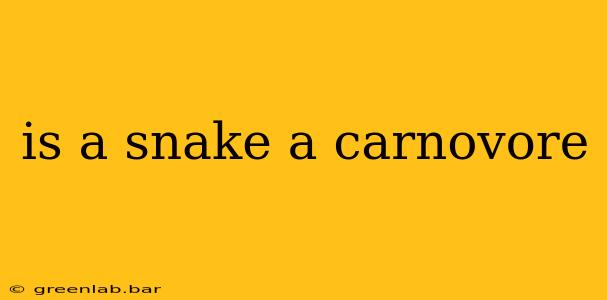Yes, a snake is a carnivore. This means that their diet consists entirely of animal matter. While there's a vast diversity within the snake family (Serpentes), encompassing thousands of species, they all share this fundamental characteristic: they are predators that consume other animals.
The Diverse Diets of Snakes
While all snakes are carnivores, their specific diets vary dramatically depending on the species, size, and their hunting abilities. This diversity is fascinating and contributes to the remarkable adaptability of snakes across diverse habitats.
What Do Snakes Eat?
Snake diets can include:
- Small mammals: Mice, rats, rabbits, voles, and shrews are common prey for many snake species. Larger snakes can even take down larger mammals.
- Birds: Snakes often prey on birds' eggs, nestlings, and adult birds, particularly those that are ground-dwelling or easily accessible.
- Reptiles: Lizards, other snakes (in some cases), and even turtles are consumed by certain snake species.
- Amphibians: Frogs, toads, and salamanders are frequently found on the menu for many snakes.
- Fish: Aquatic snakes often specialize in hunting fish, using their agility and specialized adaptations for underwater hunting.
- Invertebrates: Some smaller snake species consume insects, spiders, and other invertebrates. This is particularly true of some smaller, more slender species.
How Snakes Hunt and Kill Their Prey
Snakes have evolved a variety of hunting strategies. These range from ambush predators, patiently waiting for unsuspecting prey to pass by, to active hunters that actively pursue and stalk their food. Killing methods are equally diverse and include:
- Constriction: Many snakes, such as pythons and boas, kill their prey by constricting them, squeezing tightly until blood flow is cut off and the prey suffocates.
- Venom: Venomous snakes inject venom into their prey to paralyze or kill it, before consuming it. The venom's composition varies greatly between species, and its effects can range from mild discomfort to rapid death.
- Ingestion Whole: Unlike mammals with teeth for tearing and chewing, snakes swallow their prey whole. Their jaws are incredibly flexible and their skulls can dislocate to accommodate surprisingly large meals.
Exceptions and Misconceptions
While the overwhelming majority of snakes are carnivorous, there are some nuances:
- Opportunistic Feeding: Some snakes may occasionally consume non-animal matter, like plant material, but this is not a significant part of their diet and is often accidental. They are still considered carnivores.
- Dietary Shifts: A snake's diet can change over its lifetime as it grows, transitioning to larger prey as it matures.
Conclusion
In summary, snakes are indeed carnivores, relying entirely on animal prey for their sustenance. Their diverse diets, hunting strategies, and adaptations highlight the fascinating evolutionary success of this remarkable group of reptiles. Understanding the carnivorous nature of snakes is crucial to appreciating their roles within ecosystems and their remarkable diversity.

